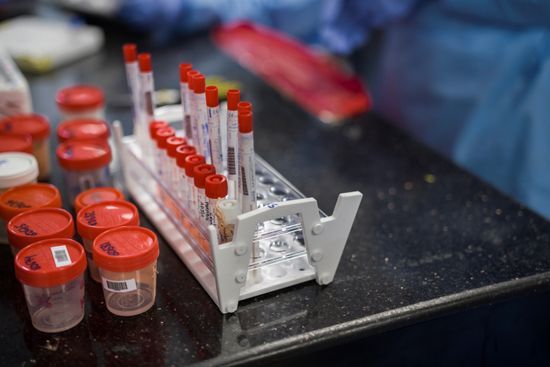
All personnel performing SARS-CoV-2 antigen rapid diagnostic tests (Ag-RDT) need to understand how to safely perform testing, ensure quality testing and interpret results. This course was developed by WHO and FIND, the global alliance for diagnostics, to provide theoretical knowledge on SARS-CoV-2 Ag-RDT testing. The learning package consists of 10 modules, which include recorded presentations and videos.
Please note: These materials were launched on 12/07/2021.
Photo credits: WHO / Blink Media / N.K. Acquah
Idioma: English
English
COVID-19
Información del curso
This course is also available in the following languages:
Español - Português - Казақ тілі - тоҷикӣ - Русский - العربية
Overview: SARS-CoV-2 antigen rapid diagnostic tests (Ag-RDT) are being used globally to test suspect COVID-19 cases in contexts where PCR diagnostic may not be available, often at subnational level. This course aims to provide Ag-RDT users with an understanding of the theoretical and practical components of SARS-CoV-2 Ag-RDT testing. It does not intend to address the implementation of Ag-RDT testing across the diagnostic network. It targets personnel involved in SARS-CoV-2 testing, including healthcare workers, laboratory workers and public health officers.
Course duration: 2.5 hours.
Certificates: A Record of Achievement will be issued to participants who receive at least 80% on the post-test. Participants who receive a Record of Achievement can also download an Open Badge for this course. Click here to learn how.
Speakers:

Dr. Belinda Herring,
Laboratory Technical Officer,
Emergency Preparedness and Response,
Health Emergencies Programme,
WHO Regional Office for Africa (AFRO)

Dr. Céline Barnadas,
Laboratory Technical Officer,
Country Readiness Strengthening, Health Emergencies Programme,
World Health Organization Headquarters

Dr. André Trollip,
Senior Technical Officer,
FIND, the global alliance for diagnostics

Mr. Francis Yesurajan Inbanathan,
Laboratory Technical Officer,
Infectious Hazards Management, Health Emergencies Programme,
WHO Regional Office for South East Asia (SEARO)

Ms. Devy M. Emperador
Pandemic Preparedness Team,
Global Health Security and Emerging Threats Programme,
FIND, the global alliance for diagnostics
The development of this course has been supported in parts by the German Federal Ministry of Health (BMG) COVID-19 Research and development funding to WHO.
In collaboration with FIND, the global alliance for diagnostics.

Lo que aprenderá
- Describe the role of antigen testing in the COVID-19 response
- Explain the importance of ensuring quality testing and how to minimize errors
- Describe how to collect and analyse routine testing data to monitor test performance
- Describe how to safely collect samples, conduct SARS-CoV-2 Antigen RDT testing, interpret the results.
A quién se dirige este curso
- Ag-RDT users
Contenido del curso
Module 1: Introduction:
This introductory module gives an overview of the course contents and objectives.Module 2: Overview of SARS-CoV-2 testing:
By the end of this module, you should be able to: explain the role of diagnostics in the care of patients with COVID-19 and to describe the different diagnostics for COVID-19 and where they may be used.Module 3: SARS-CoV-2 testing strategies:
By the end of this module, you should be able to: explain the key recommendations for the use of SARS-CoV-2 Antigen RDTs; to describe scenarios in which SARS-CoV-2 Antigen RDTs should be used and to describe scenarios in which SARS-CoV-2 Antigen RDTs should not be used.Module 4: Quality testing using SARS-CoV-2 antigen RDTs:
By the end of this module, you should be able to: describe what is quality testing and why is it important; explain the types of inaccurate results and their consequences and to list common errors in the pre-testing, testing and post-testing phases and how to avoid them.Module 5: Safety for SARS-CoV-2 antigen RDT testing:
By the end of this module, you should be able to: describe what personal protective equipment (PPE) is needed and how to use it ; explain how to prepare and use disinfectants and to explain how to safely perform tests and safely dispose of waste.Module 6: Sample collection:
By the end of this module, you should be able to: describe the personal protective equipment (PPE) required for sample collection ; explain how to prepare your sample collection workstation/area ; describe what samples are recommended for SARS-CoV-2 testing ; describe the precautions to take when collecting samples for SARS-CoV-2 testing and describe how to package samples for transport.Module 7: Preparation for testing: Supplies:
By the end of this module, you should be able to: list and identify all the supplies required for SARS-CoV-2 Antigen RDT testing; list and identify all the components of SARS-CoV-2 Antigen RDT kits; explain the principles of stock management; explain when and how to order supplies; describe how to inspect the delivery of supplies before acceptance; explain the “first expired, first out” principles when managing SARS-CoV-2 Antigen RDT consumables; describe how to keep kits and supplies under proper storage conditions.Module 8: Performing the SARS-CoV-2 antigen RDT:
By the end of this module, you should be able to: describe the key steps to follow to perform SARS-CoV-2 Antigen RDTs and to explain how to interpret individual test results.Module 9: Using SARS-CoV-2 RDT data:
By the end of this module, you should be able to: list what documents and records should be available at the testing site; describe the contents of the SARS-CoV-2 Antigen RDT logbook and how to use it ; describe the purpose of quality indicators; list the quality indicators to be monitored for SARS-CoV-2 Antigen RDTs and explain how to analyze SARS-CoV-2 Antigen RDT data.Module 10: Assuring quality results:
By the end of this module, you should be able to: define quality assurance (QA) and its main components; describe the origin of quality control (QC) materials; define External Quality Assessment (EQA) and its main components and to describe the process of supervisory visits.Post-test
Matricularme en este curso
Requisitos para el certificado
- Obtenga un certificado de estudios al obtener más del 80% del número máximo de puntos de todos los trabajos evaluados.
- Obtenga una insignia digitale abierta al completar el curso.